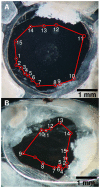Optical scattering measurements of laser induced damage in the intraocular lens
- PMID: 22348128
- PMCID: PMC3277504
- DOI: 10.1371/journal.pone.0031764
Optical scattering measurements of laser induced damage in the intraocular lens
Abstract
This study optically determines whether the amount of light scatter due to laser-induced damage to the intraocular lens (IOL) is significant in relation to normal straylight values in the human eye. Two IOLs with laser-induced damage were extracted from two donor eyes. Each IOL had 15 pits and/or cracks. The surface area of each pit was measured using a microscope. For 6 pits per intraocular lens the point spread function (PSF) in terms of straylight was measured and the total straylight for all 15 pits was estimated. The damage in the IOLs was scored as mild/moderate. The total damaged surface areas, for a 3.5 mm pupil, in the two IOLs were 0.13% (0.0127 mm(2)) and 0.66% (0.064 mm(2)), respectively. The angular dependence of the straylight caused by the damage was similar to that of the normal PSF. The total average contribution to straylight was log(s) = -0.82 and -0.42, much less than the straylight value of the normal eye.The straylight due to normal levels of laser induced damage of the IOL is much lower than normal straylight values found clinically for the normal eye and may therefore be considered not significant.
Conflict of interest statement
Figures




Similar articles
-
Light scattering levels from intraocular lenses extracted from donor eyes.J Cataract Refract Surg. 2017 Sep;43(9):1207-1212. doi: 10.1016/j.jcrs.2017.06.044. J Cataract Refract Surg. 2017. PMID: 28991619
-
Retinal straylight in patients with monofocal and multifocal intraocular lenses.J Cataract Refract Surg. 2008 Mar;34(3):441-6. doi: 10.1016/j.jcrs.2007.11.021. J Cataract Refract Surg. 2008. PMID: 18299069
-
Comparison of ocular straylight after implantation of multifocal intraocular lenses.J Cataract Refract Surg. 2016 Apr;42(4):618-25. doi: 10.1016/j.jcrs.2016.02.022. J Cataract Refract Surg. 2016. PMID: 27113887 Review.
-
Impact of intraocular lens material and design on light scatter: In vitro study.J Cataract Refract Surg. 2014 Dec;40(12):2120-7. doi: 10.1016/j.jcrs.2014.10.017. Epub 2014 Nov 24. J Cataract Refract Surg. 2014. PMID: 25465690
-
Ocular straylight in the normal pseudophakic eye.J Cataract Refract Surg. 2015 Jul;41(7):1406-15. doi: 10.1016/j.jcrs.2014.10.035. J Cataract Refract Surg. 2015. PMID: 26287879 Review.
Cited by
-
Comparison of a hydrophilic and a hydrophobic apodized diffractive multifocal intraocular lens.Int Ophthalmol. 2013 Oct;33(5):493-500. doi: 10.1007/s10792-013-9727-5. Epub 2013 Feb 5. Int Ophthalmol. 2013. PMID: 23381387 Free PMC article.
-
Cataract surgeon viewpoints on the need for novel preventative anti-inflammatory and anti-posterior capsular opacification therapies.Curr Med Res Opin. 2019 Nov;35(11):1971-1981. doi: 10.1080/03007995.2019.1647012. Epub 2019 Aug 28. Curr Med Res Opin. 2019. PMID: 31328581 Free PMC article.
-
Changes in Intraocular Straylight and Visual Acuity with Age in Cataracts of Different Morphologies.J Ophthalmol. 2017;2017:5649532. doi: 10.1155/2017/5649532. Epub 2017 Jul 31. J Ophthalmol. 2017. PMID: 28831307 Free PMC article. Review.
-
Seven-year follow-up of unilateral multifocal pseudophakia in a child.Int Ophthalmol. 2017 Feb;37(1):267-270. doi: 10.1007/s10792-016-0232-5. Epub 2016 Apr 18. Int Ophthalmol. 2017. PMID: 27090802
References
-
- Awasthi N, Guo S, Wagner BJ. Posterior capsular opacification: a problem reduced but not yet eradicated. Arch Ophthalmol. 2009;127:555–562. - PubMed
-
- Trinavarat A, Atchaneeyasakul L, Udompunturak S. Neodymium:YAG laser damage threshold of foldable intraocular lenses. J Cataract Refract Surg. 2001;27:775–780. - PubMed
-
- Newland TJ, McDermott ML, Eliott D, Hazlett LD, Apple DJ, Lambert RJ, Barrett RP. Experimental neodymium:YAG laser damage to acrylic, poly(methyl methacrylate), and silicone intraocular lens materials. J Cataract Refract Surg. 1999;25:72–76. - PubMed
-
- Mamalis N, Craig MT, Price FW. Spectrum of Nd:YAG laser-induced intraocular lens damage in explanted lenses. J Cataract Refract Surg. 1990;16:495–500. - PubMed
-
- Stark WJ, Worthen D, Holladay JT, Murray G. Neodymium: YAG lasers. An FDA report. Ophthalmology. 1985;92:209–212. - PubMed
MeSH terms
LinkOut - more resources
Full Text Sources

